| Dec-07-16 | | Straclonoor: Nice game by Berger, who shows his power in difficult endgame. |
|
Oct-19-18
 | | KEG: Maroczy, Pillsbury, and Schlechter tied for first at Munich 1900. This game was the only loss any of the three of them suffered before the playoff (in which Maroczy lost the first game to Pillsbury and then dropped out). Thus, this game went a long way toward determining how this game concluded. Had Maroczy won Munich 1900, then after winning Monte Carlo 1902 (ahead of Pillsbury, Tarrasch, Janowski, Schlechter, arshall, Teichmann, and Tchigorin) he would have had solid grounds for seeking a match for the title against Lasker. Thus, Berger's victory over Maroczy in this game may have had important repercussions in the history of chess (though I doubt Maroczy would have had much of a chance in a match against Lasker, especially considering Maroczy's dismal record against Lasker). Maroczy needn't have lost this game. He outplayed Berger in the opening, and had a won game by about move 18. But Maroczy got careless, and his error on move 28 allowed Berger to unleash a pretty combination that should have led to a quick victory. (Berger made heavy weather of his position after achieving a won game and the contest dragged on far longer than it need have). 1. d4 d5
2. e3 e6
3. Nf3 Nd7
An odd choice by Maroczy, perhaps hoping to confuse his less experienced opponent (who indeed misplayed the opening). 3...c5; 3...Nf6; and 3...Be7 were all theoretically better. After Maroczy's 3...Nd7, the position was:

click for larger view4. Nbd2
Maroczy's off-beat move did indeed seem to confuse Berger, who failed to make any real effort (i.e., 4. c4 or 4. Bd3) to punish Maroczy's odd-ball third move. 4... f5
This move, which seems to be attempting some sort of Stonewall formation, looks like another attempt to befuddle Berger. 5. Bd3
5. c4 or 5. Bd3 or perhaps 5. b3 were better, though Berger's move certainly gave nothing away and left him approximately equal chances. 5... Qf6
More strange opening play by Maroczy, who again avoided the more obvious (and almost certainly better) alternatives (i.e., 5...Ngf6 or 5...Bd6 or 5...c6). The resulting position reveals just how eccentric Maroczy's play was in the opening here: 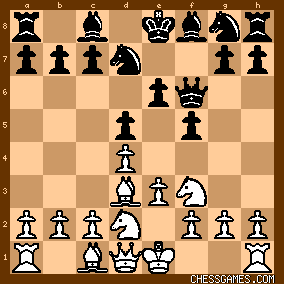
click for larger view6. c4
Giving us something akin to a Queen's Gambit...
6... c6
...Slav-style!
7. Qb3
7. Qc2 or 7. b3 were surely better. But with Maroczy's weird play to this point, Berger still had the better chances even after the text. Indeed, Berger retreated his Queen to c2 two moves later. 7... Bd6
Pillsbury or Marshall would surely have tried 7...g5 here. But Maroczy, who was now seemingly done with offbeat play, now shifted to his normal careful style. On balance, the text, though less enterprising than 7...g5, was probably best. 8. cxd5
8. 0-0 or 8. g3 were good and probably better alternatives. Any advantage Berger had enjoyed was now gone. 8... exd5
9. Qc2
An implicit acknowledgement that his 7th move was misguided. 9... Nh6
9...Ne7 looks better.
10. Nb3 0-0
11. Bd2 Qe7
The position was now:
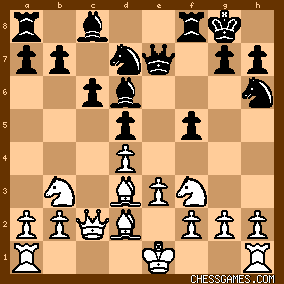
click for larger viewFrom this roughly even position the game quickly went downhill for Berger, and--as I will discuss in my next post on this game-- Maroczy soon appeared on the verge of a quick victory. |
|
Oct-19-18
 | | KEG: Post II
12. 0-0-0?
An ugly and awful move. Berger's King on c1 is just asking for trouble. 12.0-0 (getting the king to safety where it belongs) or the prophylactic 12. a3 or 12. h3 were all much better. 12... Nf6!
A move that had everything going for it: it releases the c8 Bishop; it brings the d7 Knight into play; it defends h7; it provides a new defender for the f5 pawn. Beyond doubt, at this point Maroczy had much the better game. 13. h3
Why not at least get the White King off the c-file with 13. Kb1. Alternatively, 13. Ne5 allows Black to win a pawn but at the cost of giving White all sorts of counterchances. 13... Ne4
14. Bc3
Why put the Bishop here? 14. Be1 or 14. Rhf1 were better. 14... Be6
14...Nf7 or 14...b6 were better.
15. Ne5
Berger may have been lost after this lemon. The following exchanges gave Black (Maroczy) something pretty close to a strategically won game. Berger should have played 15. Kb1 (as previously discussed) or 15. Rhf1. 15... BxN
16. BxN fxB
17. dxB
The dust has settled and Maroczy has emerged with decidedly better (and possibly winning) position: 
click for larger view17... c5!
Maroczy knew what to do here. Berger's King certainly does not look like a happy camper. 18. Kb1
Berger should have played 18. Qe2 to stop b5 before a Black pawn rush overran the White Queenside and the vulnerable White Queen. 18... Rad8
18...b5 or 18...a5 would have begun a King-hunt from which Berger likely would not have survived. 19. Qe2
It was time for Berger to organize an emergency defense of his Queen-side. 19. Nc1 was the best chance of doing so. 19... b6
20. f4 exf3 e.p.
21. gxf3
A glance at the position reveals Berger's plight: 
click for larger view21... Qf7
Maroczy was still on top after this move, but 21...Nf5 was clearly indicated. It would leave him all sorts of threats (e.g., d4; Qh4; etc.). 21...Qh4 was also good. 22. f4
Berger got to play f4 on both his 20th and 22nd moves. This latest move involved a sacrifice of his h3 pawn--a Trojan Horse Maroczy should have resisted. 22... Bxh3?
The "?" is for the bad idea behind the move rather than for the move itself (which still leaves Maroczy much better situated). The position now was: 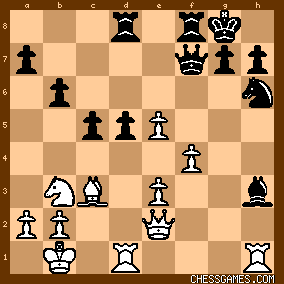
click for larger viewThis move involved a little tactical trick. 23. RxB was impossible because of the Queen fork 23...Qf5+ winning the exchange. Thus Maroczy won a pawn with his 22nd move. But, as I will discuss in my next post on this game, Maroczy's move opened the h-file for Berger. Coupled with the already open g-file, Maroczy would have to defend with great care to maintain his advantage, and to avoid getting mated. In fact, Maroczy misplayed his position, and topped it off with an oversight on move 28 that--coupled with his opening of the h-file back here on move 22-- allowed Berger a winning combination. Thus did Maroczy lose his chance to win Munich 1900 outright. |
|
Oct-20-18
 | | KEG: Post III
Maroczy's opening the h-file while snatching a pawn gave Berger chances for attack which he seized immediately. This attack should--as a theoretical matter--not have prevailed against best defense. But in the real world with the clock ticking, the coming White assault was difficult to defend, and even as fine a defensive player as Maroczy proved not to be up to the task. 23. Rdg1!
The menacing position of Berger's Rooks on g1 and h1 certainly looks scary, as does Berger's protected passed e-pawn. For a few moves, however, Maroczy seemed up to the task of holding off Berger's attack. 23... Bf5+
23...Bg4 was another good option.
24. Ka1 Bg6
Building a fortress around his King. Berger now had to find a way to make progress against Maroczy's tight defensive King-side formation. 25. Nd2
"!"--(Tournament Book).
The Knight plans to join the attack, and is headed for g5 via f3. 25... Nf5!
Seemingly planning another little forking trick--though Maroczy decides not to pull the trigger on his next move. 26. Nf3
This left:

click for larger viewMaroczy has a tactical chance here that would probably have won the game: 26...Nxe3 (27. QxN Qxf4 28. QxQ RxQ 29. Ng5 Re8 30. e6 d4 and Black's three extra pawns definitely outweigh White's extra Knight. But Maroczy undoubtedly thought he had another tactical trick here. 26... d4?
This looks overwhelmingly strong at first blush, but has a flaw. 27. exd4
The wild 27. Ng5?! was another possibility. But Berger had chances now without going for broke. 27... cxd4
28. Bb4
The position at what proved to be the critical juncture of the game was now: 
click for larger view28... Rfe8?
If a player (Maroczy here) is going to allow an opponent two open files for two Rooks, tight defense is essential. Maroczy probably played the text as a reflex. But it loses! The Tournament Book condemned Maroczy's 29th move as the cause of his defeat. But the real error lies here. With 28...d3!, Maroczy would still have had the better chances. But after the text... 29. Ng5!!
Suddenly, Maroczy found himself beseiged by the entire White army. There is no defense. 29... Qd7
The Tournament Book gave this a "?", but in fact there is nothing to be done. The Tournament Book's suggested 29...Qb7 loses to 30. Nxh7 [if 30...BxN 31. Qh5!]. Maroczy's best chance here was probably 29...d3, but that also appears to lose after 30. Qg4. After the text, as I will discuss in my next post on this game, Berger put Maroczy away with a fine combination, the position now being: 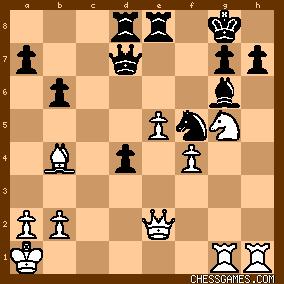
click for larger viewWhite to move and win. |
|
Oct-20-18
 | | KEG: Post IV
The "problem" with which I ended my last post is a lot less difficult in this format than if encountered over the board. In any case, Berger spotted the win: 30. Nxh7!
"!"--(Tournament Book).
30... BxN?
Maroczy's customary caution and care seemingly deserted him at this stage. 30...Qc6 was the only real chance to offer resistance, though Black would still be theoretically lost. 31. Qh5!
Crushing, and should have led to a speedy victory instead of the 35 move continuation that was necessary when Berger failed to find the shortest route. The position was now:
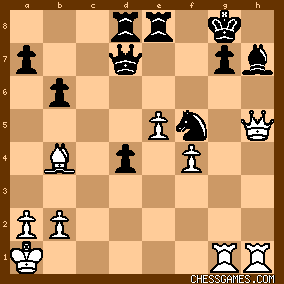
click for larger view31... g6
Maroczy might have tried to delay the inevitable with 31...Nh4 [32. QxN Qf5, though then 33. Rg5 is a killer], but neither that move nor the text should have allowed him to prolong the game. 32. Rxg6+!
"!"--(Tournament Book).
Berger's combination is so pleasing it deserves another diagram: 
click for larger view32... Kh8
If 32...BxR White mates in three (33. Qh8+ Kf7 34. Qf6+ Ng7 35. Rf6 mate). 33. e6! Qb7
There is nothing better.
34. e7! QxR+
If 34...Rxe7 35. BxR QxB 36. QxN Rg8 37. RxR+ KxR 38. Rg1+ winning the Queen with mate soon to follow after 38...Qg7 [and if 38...Kh8 39. Qc8+ and White mates in two] 35. QxQ Rc8
This left:
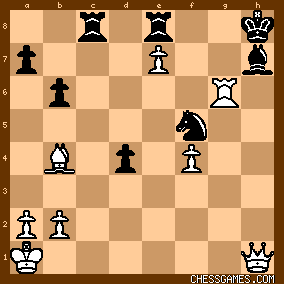
click for larger viewMaroczy was not that far behind nominally in material, but a look at the board shows that he had no realistic hopes. But he played on, and Berger found closing out the game more difficult than it should have been. 36. Rg5
The Tournament Book unfairly criticized this move, claiming that 36. a4 was stronger. But Berger had seen farther, and apparently noticed that 36. a4 would allow Black to muster up a tad of counterplay with 36...Rc1+ 37. QxR BxR. The text was more accurate and should have won quickly. 36... Ne3
37. a3
The piece sacrifice with 37. b3 would be cute (if then 37...Nc2+ 38. Kb2 NxB White finishes neatly with 39.Qh6 with mate soon ton follow). 37. f5 was also crushing. But there is nothing wrong with Berger's move. 37... Nc2+
38. Ka2 NxB
Anything else leads to mate before long.
39. axN Rxe7
40. Qh6 Rg8
41. Qf6+ Rgg7
The position was now:

click for larger viewBerger had played well since winning Maroczy's Queen and the game looks nearly over. But from here, as I will discuss in my next post on this game Berger missed opportunities to close out the game quickly and the contest was extended another 25 moves. |
|
Oct-21-18
 | | KEG: Post V
From the point at which I ended my last post, Berger did not always find the most forcing continuations, but he never let Maroczy back in the game. It is easy at this remove of time sitting with my computers to fault Berger's technique. But it must be recalled that the three players who tied for first at Munich 1900 (prior to the playoffs) (Pillbury, Schlechter, and Maroczy) scored 28 wins and 1 defear against the rest of the field. This was the lone loss sustained by the three top finishers. So if Berger sometimes looked clumsy in closing out this game, the fact is that he DID close it out successfully. All of my following comments must be read with this in mind. 42. Qxd4
42. f5 and 42. Rh5 were both faster routes to victory. 42... Rd7
43. Qf6 Rdf7
44. Qd8+ Bg8
The position was now:
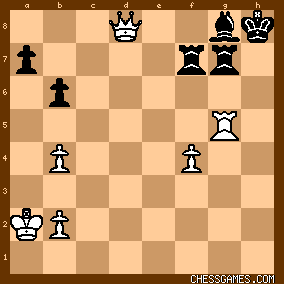
click for larger view45. RxR
There was no rush for Berger to trade Rooks, and he could have closed in on the Queen-side first with 45. Ka3 or 45. b3. The text, however, was plenty good enough, and Berger much have been relieved to reduce Maroczy's material and reduce the risk of some tactical trick by his celebrated opponent. 45... KxR
46. Ka3
46. Qg5+ first was more forceful.
46... Bh7
47. Ka4
Berger's plan was slow, but it did not imperil his win. It just meant he had to work longer and harder. 47... Bg6
48. Qd4+ Kh7
49. Kb5 Bf5
50. Qd6 Kg7
51. Qb8 Bg6
52. Kc4
The position was now:
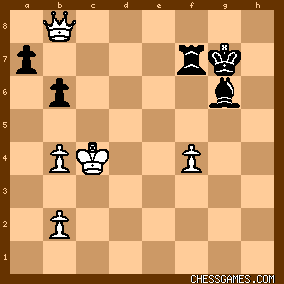
click for larger viewBerger was making progress slowly, but he was making progress. 52... Rd7
Maroczy could perhaps have make Berger's task a bit move difficult with 52...Re7 or 52...Bf5 53. Qe5+ Kf8
54. f4
54. Qf6+ or 54. b5 were more accurate.
54... Bf7+
A little trap.
55. Kc3!
55. Kb5 would of course lose the Queen to 55...Rd5+ and leave Maroczy with the only chances to win. 55... Kg8
55...Rd5 would have offered sturdier resistance, but with no real ultimate chance of saving the game. 56. f6 Kf8
Forced.
57. b5
57. Qf4 was stronger, but the text was fine.
57... Bd5
A sloppy move that gave Berger a quick means of ending the game. 57...Be8 or 57...Bg6 were better. This left:
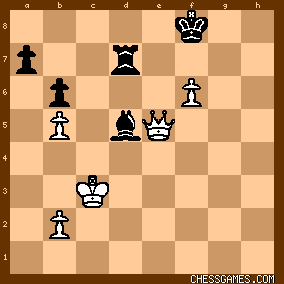
click for larger viewI will cover the balance of the game in my next post. |
|
Oct-21-18
 | | KEG: Post VI
58. Kd4
Berger again missed the most forcing lines (i.e., 58. Qh5 or 58. Qf5). 58... Be6+
58...Bf7+ was a much better try. Berger now finished briskly. 59. Ke3
As part of the final assault, the White King moves to protect the f6 pawn leaving the White Queen to snuff out further resistance. 59... Kf7
60. Qg5
Maroczy now had no defense:
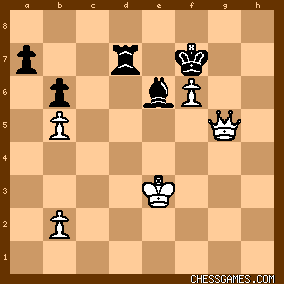
click for larger view60... Bd5
61. Kf4 Ke6
Maroczy, if he wanted to play on, should have tried to maintain his shell of a defense with 61...Be6, though he had no realistic hopes even then assuming decent play by Berger. 62. b4!
Ending any chance for Maroczy's King to try to find chances by getting his King to c5, the position now being: 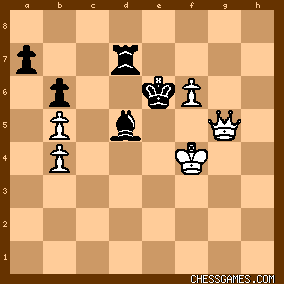
click for larger view62... Kf7
63. Ke5
63. Qg7+ was equally decisive.
63... Bc4
With Berger now weaving mating nets around the Black King, the only way to forestall mate for even a little while was 63...Ke8. Maroczy's plan to win the b5 pawn, of course, gets him nowhere. 64. Qh5+ Kf8
65. Qg4
Gladly giving up the b5 pawn so be able to invade the Black camp with his Queen. 65... Bxb5
66. Qh4
This left:
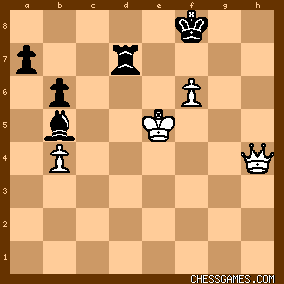
click for larger viewEither the White Queen or the White King must now penetrate with devastating effect (i.e., mate before too long). 1-0.
Berger's play in the final assault was precise and instructive. Despite Berger's occasionally lax play, the ending provides excellent material on how to play a Queen vs. Rook and Bishop ending. |
|
|
|
|





































